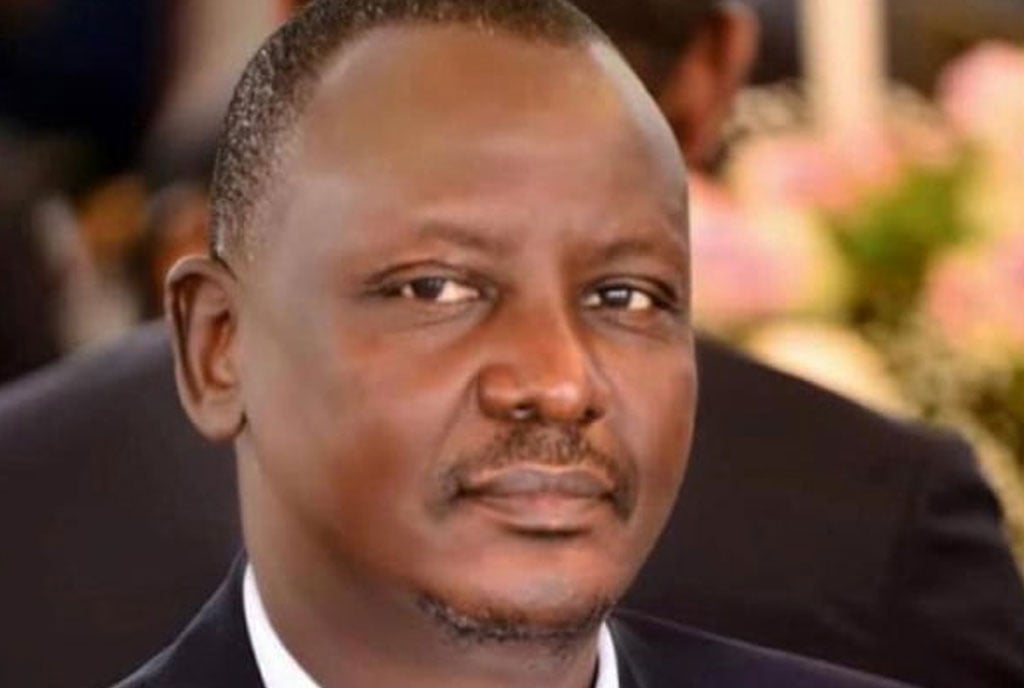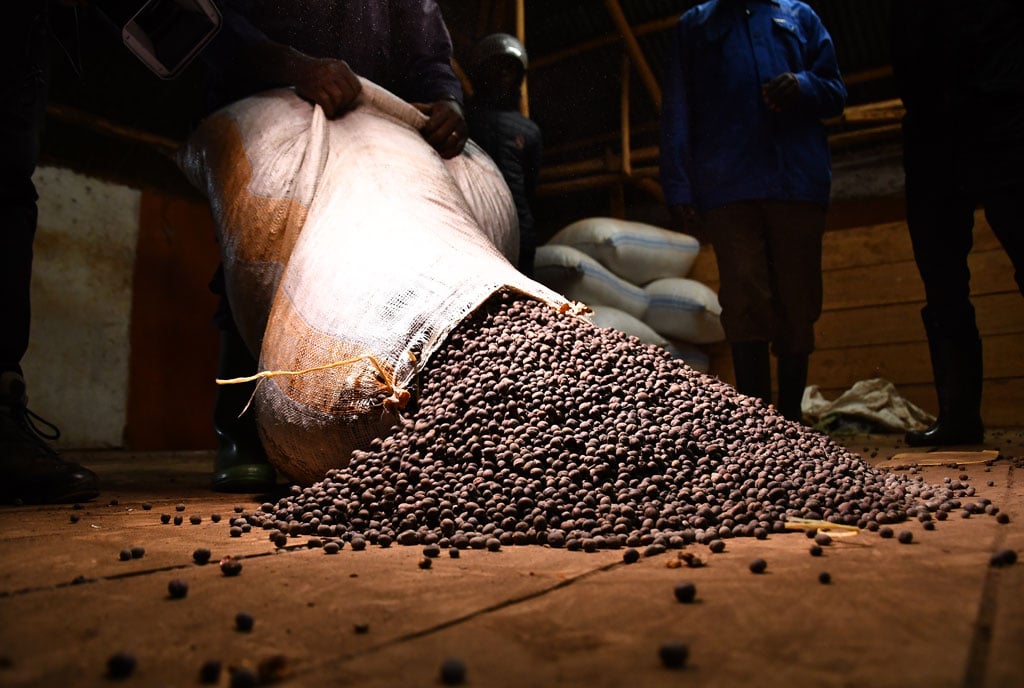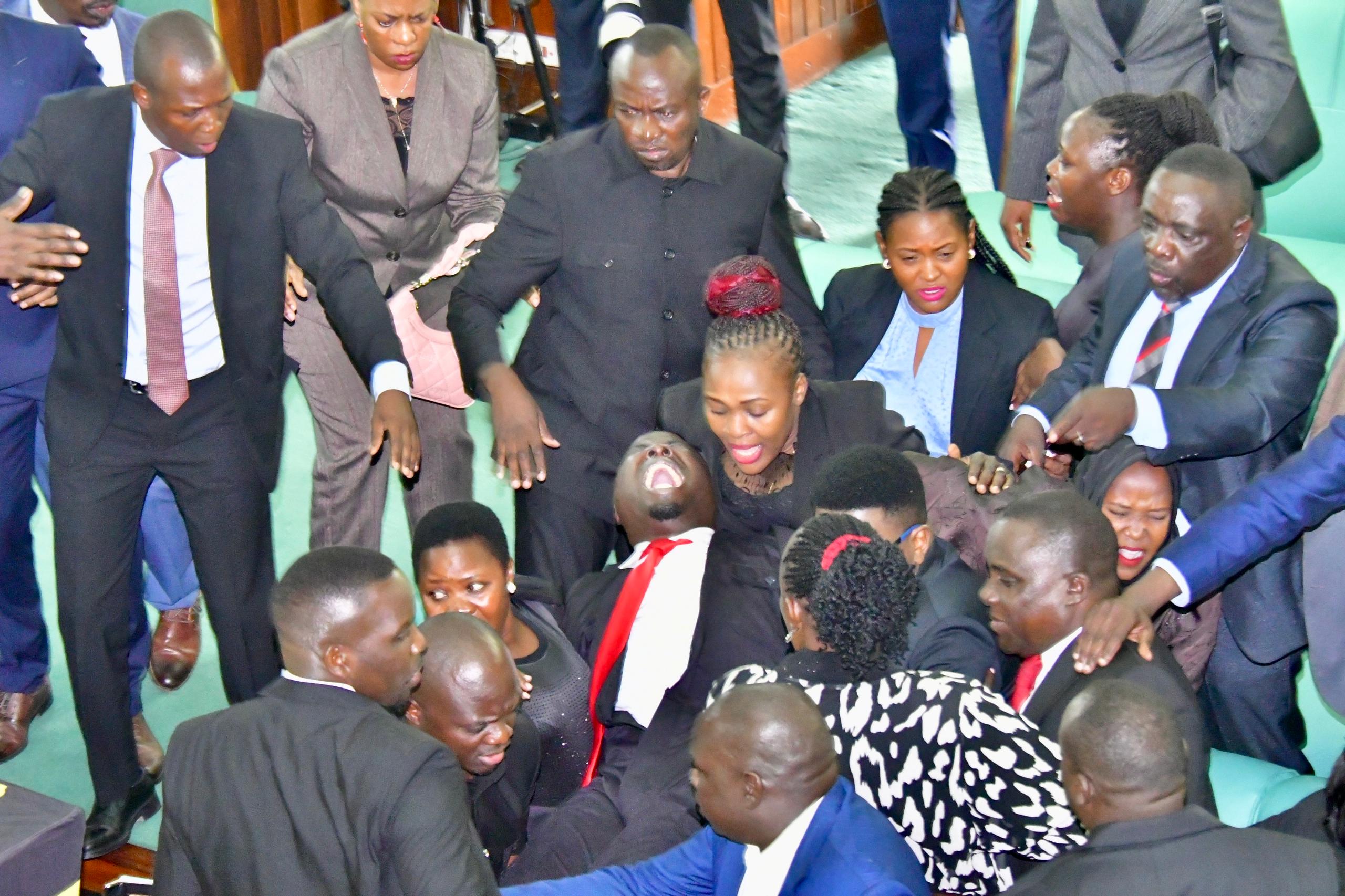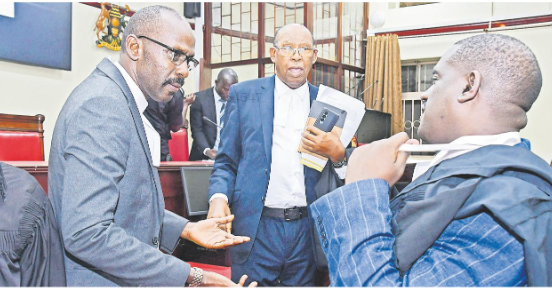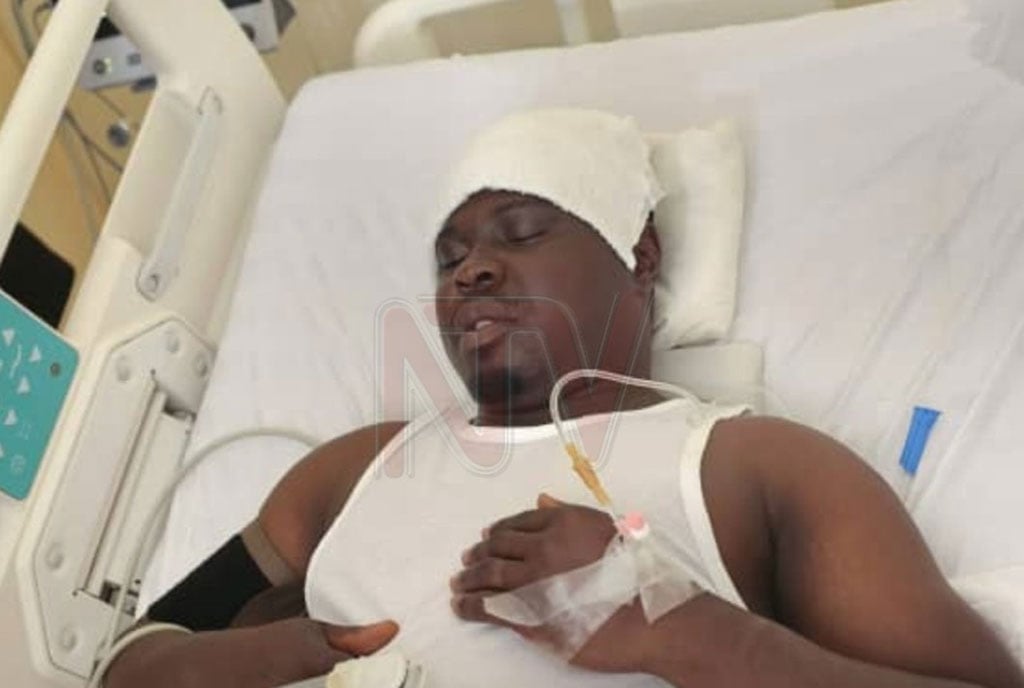
Molly Katanga, the accused person, follows the High Court proceedings via Zoom yesterday. Photo/ ISAAC KASAMANI
For consecutive two days, police pathologist Richard Ambayo has had his rough share in the witness dock in the high-profile case trial in which five people are charged with the murder of Kampala businessman Henry Katanga. While concluding his testimony yesterday, Mr Ambayo informed the court presided over by Justice Isaac Muwata that he received Katanga’s body with a request note, saying he shot himself during a domestic brawl. Our reporters Anthony Wesaka & Juliet Kigongo were in court and bring you the excerpts, including the bitter exchange between the defence and prosecution lawyers that climaxed with Counsel Peter Kabatsi shooting down Assistant DPP Samali Wakooli for being a junior to him.
At 10:27am, presiding judge Isaac Muwata makes his way into the courtroom at the High Court in Kampala yesterday. The court clerk calls for Henry Katanga’s case file.
Prosecutor Samali Wakooli: My lord, accused number one [Ms Molly Katanga] is appearing via Zoom and the co-accused persons are in court. My lord, for the prosecution, we are appearing as before. Mr Mwesigwa Rukutana is appearing on watching brief. The accused representation is as yesterday (Wednesday). My lord, the matter is coming up for further cross-examination.
Defence lawyer Peter Kabatsi: Yes, we are as of yesterday, except for counsel Jet Tumwebaze.
Defence lawyer Bruce Musinguzi: As the witness takes to the dock yesterday, my colleague raises concerns with some sections of the media.
Judge: Is he here in court?
Defence lawyer Musinguzi: Not here.
Judge: Tell him to refrain himself; otherwise, we shall sanction him. Can we continue, are you ready?
Defence lawyer Elison Karuhanga: My lord, should the witness be seated or take to the dock
Judge: Let him go to the stand unless he is already tired (laughter in court).
Karuhanga: Doctor, yesterday you spoke about what is called a margin of abrasion, am I correct? Is it fair to say that is the mark left on the skin when the bullet enters the body?
Witness: Not always a mark.
Karuhanga: Is it fair to say a scrapping of the skin as the bullet moves forward?
Witness: No
Karuhanga: Doctor, in your evidence, you stated that you did not record a margin of abrasion on the wound on the left, correct?
Witness: Correct
Karuhanga: And doctor, the reason you give is because the bullet
Witness: The explosion effect and physical effect of the projector blew the tissue off at the near contact and that is why I didn’t see the ring of abrasion.
Karuhanga: It comes as a ball of fire?
Witness: Correct
Karuhanga: It also comes with hot gases?
Witness: Correct
Karuhanga: The burning effect is not caused the starlet shape
Witness: Its wrong
Karuhanga: Otherwise, an abrasion would be a must for an entry wound?
Witness: It’s not a must
Karuhanga: An abrasion ring can otherwise only happen at the point of entry?
Witness: Right. My lord, an amendment; most times, with rare exceptions.
Karuhanga: Doctor, I want you to look at prosecution exhibit 5G
Court clerk hands him the exhibit, which is a picture of Katanga’s remains that the pathologists took during the autopsy exercise.
Karuhanga: Can you confirm doctor that what you see there, is a hole?
Witness: Correct
Karuhanga: Can you confirm that in that you can’t see the lacerations and burning abrasion?
Witness: You can only see them at careful view.
Karuhanga: Where is the hole?
Witness: You can’t see from a distance.
Karuhanga moves closer to the witness who gets scared and asks the court for protection, saying his voice is intimidating, attracting laughter in court.
Witness: They are visible but very small.
Karuhanga: Doctor, I want you to look exhibit P5F. On the wound on the left, it was your evidence that the explosion removed the abrasion ring, correct?
Witness: That is correct
Karuhanga: The effect of the fire and the explosion was very tiny and microscopic and you couldn’t see the tearing.
Witness: That is not correct
Karuhanga: Let’s look at this particular wound. Confirm to us that is a wound on the left. Would I be right to say I can clearly see the star shape?
Witness: Yes, I can clearly see the lacerations
Karuhanga: So it’s fair to conclude that the wound on the right has lacerations and the wound on the left has microscopic?
Witness: My lord, lacerations are the same as tearing.
Karuhanga: My lord, I have a few more questions. Doctor, are you aware of the term ‘bias’?
Witness: I’m aware
Karuhanga: Doctor, would I be fair to say that it’s possible for an expert to be biased?
Witness: My lord, let him rephrase the question.
Karuhanga: Is it possible for an expert to be biased?
Witness: You will not be correct.
Karuhanga: So it’s impossible for an expert to be biased?
Witness: It’s impossible
Karuhanga: Are you aware of some of the effects of bias?
Witness: No
Karuhanga: Would it be fair to say that a person refuses to see evidence that confronts him directly?
Witness: Rephrase that question
Karuhanga: A biased person’s mind is already made up irrespective of the evidence.
Witness: My lord that is not right.
Karuhanga: What did you say about the mind of a biased person?
Witness: I’m a professional,
Karuhanga: I have not said you are biased. I have asked you if a biased person refuses glaring evidence to place them.
Witness: I don’t know.
Karuhanga: Doctor, are you also aware of the term ‘commutative bias’?
Witness: No
Karuhanga: This is when someone gives you information and biases you before you begin work causally, did that happen in this case?
Witness: No
Karuhanga: Doctor, it was your evidence that the postmortem was conducted in the presence of the investigating officer, correct?

Molly Katanga’s co-accused in the dock at the High Court yesterday. Photo/ ISAAC KASAMANI
Witness: Yes
Karuhanga: …And investigating officer detective sergeant David …., correct?
Witness: Yes
Karuhanga: Doctor, I want to suggest to you that Detective Sergeant David Beiteise who told you that the entry wound was on the right.
Witness: That is not right.
Karuhanga: I want to suggest to you that even before the body was delivered at the mortuary, Detective Sergeant Beiteise and his boss, Senior Commissioner of Police Paul Kagarura had already formed the view that entry was on the right and had communicated to you, is that correct?
Witness: I don’t know about that.
Karuhanga: Did you have any conversation with Beitese about where the wound was?
Witness: No
Karuhanga: That would be strange because in his police witness statement, he said he entered the room and examined the body, the wounds were covered and on removing the badge, there were wounds, one on the left, slightly above the ear entry point and the exit was the right ear.
Prosecutor Muwaganya interjects by asking which room
Judge: He will get to that
Prosecutor Muwaganya: If he is giving a background, then that is okay.
Karuhanga: My lord, I think it’s important that my learned friends don’t continuously interrupt and we be allowed to have the process flow.
Judge: It’s okay, let’s move on
Karuhanga: After writing your report, you shared it with the investigating officer, is that correct?
Witness: When the report was complete, the team of investigating officers signed
Karuhanga: That is on 2nd of November?
Witness: No my lord, it was not on the very day, I can’t remember the day when the report was taken but it’s not on 2nd November because that is when we did the postmortem examination.
Karuhanga: Do you have a copy of your report?
Karuhanga: Did Beteise David share his view with you?
Witness: No
Karuhanga: Was that the date the postmortem was sent out?
Witness: It wasn’t sent on that very day
Karuhanga: Is the date is backdated
Witness: No
Karuhanga: So your report was forwarded to Bugolobi.
Witness: It was picked by the liaison officer
Karuhanga: Are you aware that your report was first published on an online publication known as Chimp Reports on November 21, 2023, I want him to look at the report and confirm whether what was published is the same as his report.
Witness: My lord, it’s so faint.
Karuhanga: Let the court look at it to determine its faintness.
Judge: Admit it for identification
Prosecutor Samali Wakooli stands up and objects to the identification
Karuhanga: You said there was a starlet shaped bullet wound measuring ...I want you to look at P5G, that is exactly that wound and you have measured, can you show the court how you measured?
Judge: He showed us yesterday
Witness: (He goes ahead and illustrates to court).
Karuhanga: All the tearing leaves a wound
Witness: Tearing leaves a wound
Karuhanga: Your claim that the entry wound is larger than the exit wound is not measured
Witness: Not true
Karuhanga: There are deliberate falsehoods
Witness: They are not there
Karuhanga: But if we find one!
Judge: He is not the one who establishes.
Karuhanga: You testified in your evidence that prior to the examination, there was identification of the body.
Witness: We confirmed the identification as the body came with an identifier.
Karuhanga: I want to put it to you that Martha Nkwanzi Katanga didn’t identify the body
Witness: She identified and signed for the body
Karuhanga: I want to notify you that at that time, Martha was nowhere near the mortuary, your claim is a lie
Witness: That can’t be true
Judge: Your time is over
Karuhanga: Most obliged
Defence lawyer MacDusman Kabega: Doctor, do you know Martha Nkwanza?
Witness: Master Katanga (laughter in court).
Kabega: Let me put it this way, you don’t know her
Witness: Can you rephrase that question, they are two in one.
Judge: Do you know a person called Martha Nkwanzi, do you know him or her?
Witness: No
Kabega: I want to suggest to you that you don’t know her because you have never seen her.
Witness: My lord, I see so many people, so cannot recall.
Kabega: Let’s turn to the mortuary; you said the body came with a request?
Witness: Correct
Kabega: Doctor, in your evidence, you said you are the one who filled up this postmortem report, is that correct?
Witness: My lord, it is correct, this is the product of a joint team.
Kabega: Even the judge is getting confused with you, isn’t your evidence that you are the one who filled up this report?
Witness: which one, 48B?
Witness: My lord, it’s my evidence that we did a postmortem ….
Judge: Are you the one who filled in the form?
Witness: Which form?
Kabega: Do you have another postmortem report rather than 48B
Witness: My lord, I need to confirm that.
Kabega: Did you?
Witness: Yes
Kabega: Where did you get the information which you filled before the examination?
Witness: My lord, I got the information from part of 48B and 48A.
Kabega: Does it indicate the time it was made?
Witness: My lord, I don’t see that.
Kabega: Look at the right hand corner; does it indicate the time when it was made?
Witness: It indicates the time of the arrival of the body
Kabega: Doctor, you are here to answer my questions.
Witness: You are right, thank you my lord
Kabega: My question is, does it indicate the time when it was made?
Witness: No
Kabega: Does the request indicate the name of the officer making the request?
Witness: No, my lord
Kabega: Now, it’s your evidence that the bodies are brought to the mortuary by ambulance, did I hear that in your evidence?
Witness: By a vehicle
Kabega: Does the number of that vehicle appear on the request form.
Witness: No
Kabega: When the body was brought to the mortuary, it came with police form 48A?
Witness: Yes
Kabega: The police form 48A gives you a short history of what the investigations are about, yes?
Witness: Yes
Kabega: So the necessary information which they gave you was that the deceased shot himself after a domestic quarrel, correct?
Witness: Yes
Kabega: With that background, you proceeded to carry out the examination, is that correct?
Witness: Yes my lord
Kabega: Doctor, you said you have had many years of practice as a pathologist?
Witness: Four years
Kabega: In this career of yours, you may have come across some cases where some people have committed suicide like this?
Witness: Yes, people shooting the head
Kabega: In such cases like this one; you will agree with me that the head is one a favourable area?
Witness: Yes my lord
Kabega: Like in this case?
Witness: No
Kabega: And then, you proceeded to do this postmortem and indeed, confirm that this gentleman had these injuries on his head?
Witness: In this case, yes.
Kabega: And your finding was that the shooting was at a close range
Witness: Near contact
Kabega: Yes, that is consistent with people who commit suicide using guns, correct?
Witness: My lord, I have no idea, I did the post-mortem, I was not at the scene.
Kabega: Can you go to page three?
Witness goes ahead to read the part of the findings of how there were no defensive injuries on the limps during the attack.
Kabega: So in your findings, you rule out that the deceased was not engaged in a defense encounter?
Witness: I cannot tell the situation my lord.
Kabega: Where did the bullet go, I need to understand, did it go up, down?
Witness: I didn’t see the bullet, so I cannot say whether it went upwards. Half of the bullet was left to the right side more to the downwards in relation to the entry wound.
I don’t know which direction the bullet took after it exited because I’m not a forensic expert.




